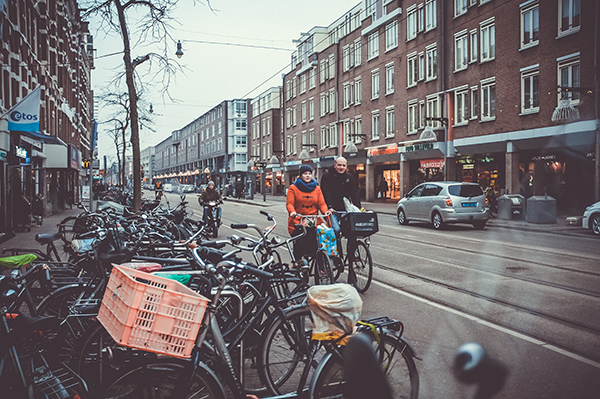Transportation is consistently ranked as one of the highest contributors of carbon dioxide emissions. Solutions to reduce the need for fossil fuel-driven transportation include supporting walkable cities, bicycle infrastructure, and mass transit.
To promote foot traffic, walkable cities are denser, more compact, and appealing. Walkable cities have well-lit, tree-lined sidewalks; safe pedestrian crossings; and connectivity with mass transit and walkable destinations such as the grocery store.
Functional transit by bicycle requires adequate bicycle infrastructure. Safe, efficient, and inclusive biking requires direct and interconnected networks; well-lit, designated pathways; appropriately-designed intersections where bicycles and cars meet; and access to secure parking, and workplace showers. Connectivity to public transport and options for city bicycle-sharing may also encourage biking.
Mass transit options such as bus, subway, tram, and commuter rail reduce individual vehicle trips and benefit entire communities with reduced air pollution, less traffic, and fewer accidents. Mass transit provides mobility to those who cannot drive and increases commuting efficiency.
Drawdown Impact
Traveling by bus instead of car can save 6.6 gigatons of carbon dioxide emissions from cars by 2050!
By opting out of traditional transportation, which depends on personal vehicles powered by fossil fuels, active and mass transport help reduce carbon emissions in many ways. Denser neighborhoods that allow for traveling on foot, bicycle, roller skates – or any other person-powered transport – reduces the need for fossil fuels. In fact, it is estimated that by 2050, 5.23 gigatons of carbon dioxide emissions can be avoided by traveling on foot or bicycle rather than single occupancy vehicle trips. Furthermore, the fossil fuels required to build and maintain personal vehicles and roadway infrastructure are avoided. Safe active transport is the preferred method of travel, as it is carbon neutral and increases the activity level of the individual.
If active transport is not possible due to infrastructure, safety, mobility limitations, or other barriers, riding mass transit is a great option. Traveling by bus, subway, tram, or commuter rail reduces the number of single occupancy vehicle trips; thus, carbon emissions for travel and maintenance are shared amongst many passengers. For instance, traveling by bus instead of car can save 6.6 gigatons of carbon dioxide emissions from cars by 2050!
Read more about the science of this drawdown activity and the impacts of solutions identified by Project Drawdown here:
- Walkable Cities“>Walkable cities
- Bicycle Infrastructure “>Bicycle infrastructure
- Public Transit“>Public transit
Why Nurses
Nurses care about individual-level fitness as well as the health of communities and environments. Active transport (walking, bicycling) and the use of mass transit (riding a bus or train) are solutions to address human health and the health of the environment. Nurses who journey by foot or bike or travel using mass transit – and who encourage their patients to do the same – are promoting personal physical health through increased physical activity as well as the health of the planet through decreased emissions. Furthermore, nurses can use their influence to advocate for cities that are more walkable, bicycle-friendly, and rich in mass transit options.
Key Areas of Action
Nurses around the world are invited to join the Nurses Drawdown movement
by taking personal and professional action in five key areas:
Supporting a clean energy future by promoting energy efficiency and advocating for a transition to renewable energy
Committing to eat a more plant-based diet, use clean-burning cookstoves, and reduce food waste
Supporting education for girls and access to family planning
Promoting walkable cities, including improving bike infrastructure and mass transit
Planting trees and protecting forests


